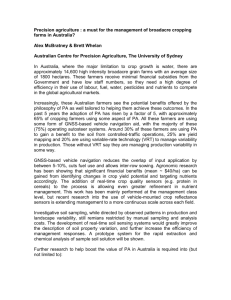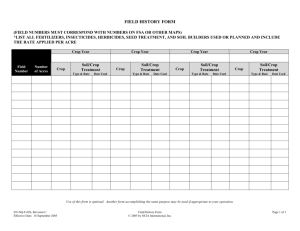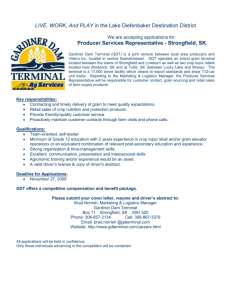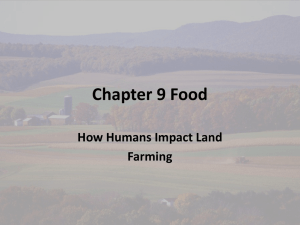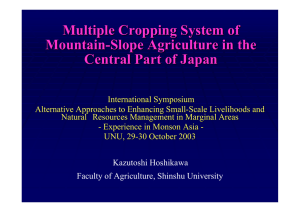dnre grain draft 20 June
advertisement
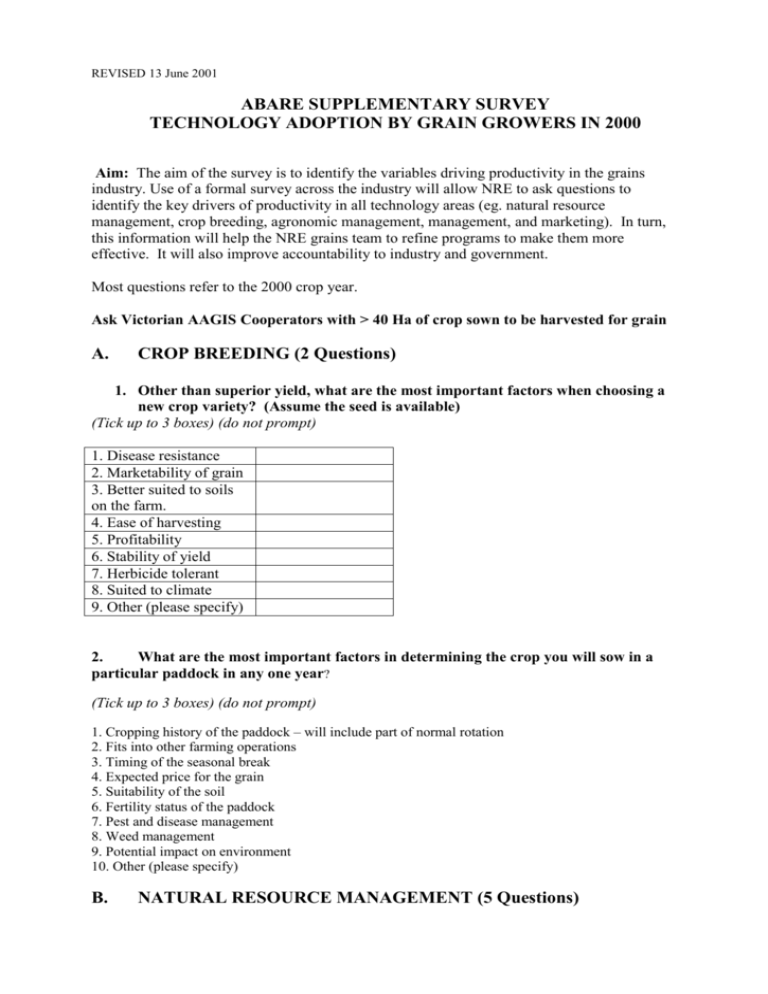
REVISED 13 June 2001 ABARE SUPPLEMENTARY SURVEY TECHNOLOGY ADOPTION BY GRAIN GROWERS IN 2000 Aim: The aim of the survey is to identify the variables driving productivity in the grains industry. Use of a formal survey across the industry will allow NRE to ask questions to identify the key drivers of productivity in all technology areas (eg. natural resource management, crop breeding, agronomic management, management, and marketing). In turn, this information will help the NRE grains team to refine programs to make them more effective. It will also improve accountability to industry and government. Most questions refer to the 2000 crop year. Ask Victorian AAGIS Cooperators with > 40 Ha of crop sown to be harvested for grain A. CROP BREEDING (2 Questions) 1. Other than superior yield, what are the most important factors when choosing a new crop variety? (Assume the seed is available) (Tick up to 3 boxes) (do not prompt) 1. Disease resistance 2. Marketability of grain 3. Better suited to soils on the farm. 4. Ease of harvesting 5. Profitability 6. Stability of yield 7. Herbicide tolerant 8. Suited to climate 9. Other (please specify) 2. What are the most important factors in determining the crop you will sow in a particular paddock in any one year? (Tick up to 3 boxes) (do not prompt) 1. Cropping history of the paddock – will include part of normal rotation 2. Fits into other farming operations 3. Timing of the seasonal break 4. Expected price for the grain 5. Suitability of the soil 6. Fertility status of the paddock 7. Pest and disease management 8. Weed management 9. Potential impact on environment 10. Other (please specify) B. NATURAL RESOURCE MANAGEMENT (5 Questions) 2 3. Was it a good weather season for crop production in 2000? Y/N 4. What was your rainfall for the 2000 growing season (April to October inclusive) ……mm. 5. Have any of the following had a significant impact on your crop yields over the past 3 years? Y 1. Soil acidification 2. Wind erosion 3. Water erosion 4. Soil compaction 5. Surface sealing 6. Organic matter decline 7. Soil fertility decline 8. Groundwater recharge 9. Salt affected land 10. Reduction in native vegetation If all Q5 = N or U.Go to Q7 N U 3 6 For each category where Q5 =Y, Have you done anything to manage the issue over the last 3 years? Codes 1 No management response 2 Minimal management response 3 Major management response 1.Soil acidification 2. Wind erosion 3. Water erosion 4. Soil compaction 5. Surface sealing 6. Organic matter decline 7. Soil fertility decline 8. Groundwater recharge 9. Salt affected land 10. Reduction in native vegetation 7. If you follow a continuous cropping program, what are the main strategies you use to maintain/increase yield? (Note: Continuous cropping is defined as a sequence of 6 or more successive crops in the same paddock) Tick up to 3. Do not prompt. 1. 2. 3. 4. Do not continuous crop Retain stubble in most years Conservation tillage, including minimum tillage, or direct drill Follow a flexible rotation which includes grain legumes 5. Apply extra fertiliser to offset nutrient removal 6. Grow green manure crops 7. Other (please specify) C. AGRONOMIC MANAGEMENT (4 Questions) 8. What are the most important weed management strategies in your cropping program? Tick up to 3 boxes. Do not prompt. 1. Identify weed species 2. Monitor weed density 3. Monitor weed populations for herbicide resistance 4. Use herbicide tolerant crops 5. Rotate herbicide groups 6. Rotate crops 7. Use threshold weed populations for management decisions 8. Use a pasture phase 9.Cultivation 10 Other (please specify) 9 Other than disease resistant crop varieties, what are the most important pest and disease management strategies in your cropping program? 4 Tick up to 3 boxes. Do not prompt. 1. Use seed dressings 2. Soil test for disease 3. Use rotations as a disease break 4. Crop monitoring for pests and diseases 5. Use disease free seed 6. Burn stubble 7. Cultivation 8. Alter time of sowing 9 Other (please specify) 10. What are the most important crop nutrition strategies in your cropping program? Tick up to 3 boxes. Do not prompt. 1. Soil test—top soil 2. Soil test—deep soil 3. Include clovers or medics or lucerne in the rotation 4. Include pulse crops in the rotation 5. Nutrition budgets including yield forecasting 6. Undertake fertiliser strip tests/trials 7. Innoculate clovers/pulses with rhizobia 8. Long fallows 9. Other (please specify) 11. What is your most important source of information on:? Code DO NOT PROMPT New varieties 1. Published trial data 2. On-farm comparison testing of options 3. Discussions with neighbours and leading farmers 4. Consultants 5. Agribusiness advisers. Eg chemical resellers and fertiliser company agronomists 6. Small discussion groups, eg. TopCrop 7 Media (newspaper, TV, radio) Disease control Weed control 5 8. GRDC updates 9. Internet 10Government research & advisory staff 11. Community group activities-Birchip Cropping Group, Southern Farming Systems 12. Other (please specify) Can the number of categories be reduced? Yes, Laurie: we have done more consolidation. Given that this would normally be a no prompt question categories that are close may be difficult to separate. Eg 3, 7, 12, 13 14 or 5 & 6. Why not a single column question similar to last years wool Q6. List up to 3 responses and keep the categories as close as possible to those used last year to enable comparison between industries. The questionnaire is a little long so rationalising this question will help. D. MANAGEMENT (5 Questions) 12. What is your main strategy to ensure that you have finance for changes on your farm? Code 1 No strategy/no plan for change 2 Save or invest when grain or other commodity prices are high 3 Keep debt low and borrow when needed 4 Develop business plans to ensure funds are available 5 Earn off-farm income 6 Other (please specify) 13. Do you have plans for major enterprise change over the next 5 years? Y/N I If answer to Q 13 is N go to Q15 14. What are your plans for major enterprise changes over the next 5 years? Indicate intended changes with a Y - Reduce grain production Reduce other existing enterprises Increase grain production Increase other existing enterprises Exit grain production Develop new farm enterprises Cease all farm production & leave farming 6 - Other (please specify) 15. Have you/your family/staff participated in any of the following groups/courses in the past 2 years? Indicate attendance with a Y TopCrop FM500 Major farming groups (eg Birchip Cropping Group, Southern Farming Systems, Mallee Sustainable Farming Project) LandCare VFF Succession Planning FarmSmart Other farming related groups/courses (please specify) 16 What percentage of your 2000 crop did you sow at the optimum time? % If Q16 = 100%, go to Q18 17. What was the main reason for not sowing all of your crop at the optimum time? Code 1. Extreme weather (eg. too dry, too wet, flood etc.) 2. Conditions not ideal but could have sown, waited for next rain but waited too long 3. Delayed moving sheep from paddocks and compromised crop preparation and sowing. 4. Machinery breakdown 5. Plant not the optimum size – sowing took too long 6. Waiting on seed/fertiliser/seed grader 7. Waiting on contractor/sharefarmer 8. Shortage of labour 9 Lack of funds 10 Other (please specify) MARKETING (1 Question) 18. Did you do any of the following to influence the net price you received for your grain in 2000/01? (Interviewer may need to explain that sale method and marketing strategies can influence net price. This can occur through receiving a higher price, and/or lower storage and handling costs) Indicate with a Y forward sold all or part of the crop used the futures market to fix a price stored grain for later sale sold grain for cash arranged direct sales to end user Other (please specify)




